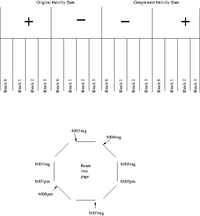Difference between revisions of "Qweak Analysis Software"
Jump to navigation
Jump to search
| (3 intermediate revisions by the same user not shown) | |||
| Line 1: | Line 1: | ||
=Helicity Structure= | =Helicity Structure= | ||
| − | The standard helicity quartet is compose of 4 helicity states. The first set is the original helicity states | + | The standard helicity quartet is compose of 4 helicity states. The first set is the original helicity states pseudo-randomly set. The second half contains the complement helicity state to the original one. |
[[File:Qweak_Helicity_Slices.png | 200 px]] | [[File:Qweak_Helicity_Slices.png | 200 px]] | ||
| + | |||
| + | The Qweak readout divides each helicity state into 4 time slices labeled block0, block1, block2, and block3. | ||
| + | |||
| + | Two PMTs are used on the end of each quartz main detector. The PMT's are called "neg" and "pos" depending on their location as shown in the figure above. | ||
=Data stream= | =Data stream= | ||
==High Current Mode== | ==High Current Mode== | ||
==Event Mode== | ==Event Mode== | ||
| + | |||
| + | |||
| + | [[Qweak]] | ||
Latest revision as of 03:44, 22 November 2010
Helicity Structure
The standard helicity quartet is compose of 4 helicity states. The first set is the original helicity states pseudo-randomly set. The second half contains the complement helicity state to the original one.
The Qweak readout divides each helicity state into 4 time slices labeled block0, block1, block2, and block3.
Two PMTs are used on the end of each quartz main detector. The PMT's are called "neg" and "pos" depending on their location as shown in the figure above.
